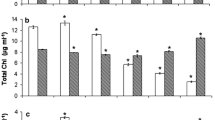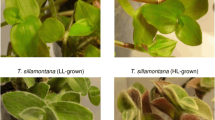Abstract
The relationships between photoinhibition and photoprotection in high and low-light-grown Ulva were examined by a combination of chlorophyll-fluorescence-monitoring techniques. Tissues were exposed to a computer-controlled sequence of 5-min exposures to red light, followed by 5-min darkness, with stepwise increases in photon flux. Coefficients of chlorophyll fluorescence quenching (1−qP and NPQ) were calculated following a saturating pulse of white light near the end of each 5-min light treatment. Dark-adapted chlorophyll fluorescence parameters (F0 and FV/FM) were calculated from a saturating pulse at the end of each 5-min dark period. Low-light-grown Ulva showed consistently higher 1−qP, i.e. higher reduction status of Q (high primary acceptor of photosystem II), and lower capacity for nonphotochemical quenching (NPQ) at saturating light than did high-light-grown plants. Consequently, low-light plants rapidly displayed photoinhibitory damage (increased F0) at light saturation in seawater. Removal of dissolved inorganic carbon from seawater also led to photoinhibitory damage of high-light-grown Ulva at light saturation, and addition of saturating amounts of dissolved inorganic carbon protected low-light-grown plants against photoinhibitory damage. A large part of NPQ was abolished by treatment with 3 mM dithiothreitol and the processes so inhibited were evidently photoprotective, because dithiothreitol treatment accelerated photoinhibitory damage in both low- and high-light-grown Ulva. The extent of photoinhibitory damage in Ulva was exacerbated by treatment with chloramphenicol (1 mM) without much effect on chlorophyll-quenching parameters, evidently because this inhibitor of chloroplast protein synthesis reduced the rate of repair processes.
Similar content being viewed by others
Abbreviations
- CAP:
-
chloramphenicol
- DIC:
-
dissolved inorganic carbon in seawater (i.e. CO2 + HCO -3 +CO 2-3 )
- DTT:
-
dithiothreitol
- 1-qP :
-
reduction status of Q, the primary acceptor of PSII, measured as described
- FM, F0, FV :
-
dark-adapted maximum, minimum and variable fluorescence, respectively
- NPQ:
-
nonphoto-chemical fluorescence quenching, measured as described
- PFD:
-
photon flux density
References
Bilger, W., Björkman, O., Thayer, S. (1989) Light induced spectral absorbance changes in relation to the epoxidation state of xanthophyll cycle components in cotton leaves. Plant Physiol. 91, 542–545
Bilger, W., Björkman, O. (1990) Role of the xanthophyll cycle in photoprotection elucidated by measurements of light induced absorbance changes, fluorescence and photosynthesis in leaves of Hedera canariensis Photosynth. Res. 25, 173–185
Björkman, O. (1987) High irradiance stress in higher plants and interaction with other stress factors. Progr. Photosynth. Res. 4, 11–18
Bradbury, M., Baker, N.R. (1981) Analysis of the slow phases of the in vivo chlorophyll fluorescence induction curve. Changes in the redox state of photosystem II electron acceptors and fluorescence emission from photosystems I and II. Biochim. Biophys. Acta 63, 542–551
Chow, W.S. (1993) Photoprotection and photoinhibitory damage. In: Molecular processes of photosynthesis, vol. 9: Advances in molecular and cell biology, Barber, J., ed. JAI Press Inc., Greenwich, Conn., USA, in press
Demmig-Adams, B., Adams III, W.W. (1992a) Photoprotection and other responses of plants to high-light stress. Annu. Rev. Plant Physiol. Plant Molec. Biol. 43, 599–626
Demmig-Adams, B., Adams III, W.W. (1992b) Carotenoid composition in sun and shade leaves of plants with different life forms. Plant Cell Environ. 15, 411–420
Demmig-Adams, B., Adams III, W.W., Heber, U., Neimanis, S., Winter, K., Krüger, A., Czygan, F-C., Bilger, W., Björkman, O. (1990) Inhibition of zeaxanthin formation and of rapid-changes in radiationless energy dissipation by dithiothreitol in spinach leaves and chloroplasts. Plant Physiol. 92, 293–301
Franklin, L.A., Levavasseur, G., Osmond, C.B., Henley, W.J., Ramus, J. (1992) Two components of onset and recovery during photoinhibition of Ulva rotundata. Planta 186, 399–408
Greer, D.H., Berry, J.A., Björkman, O. (1986) Photoinhibition of photosynthesis in intact bean leaves, role of light and temperature and requirement for chloroplast protein synthesis during recovery. Planta 168, 253–260
Havaux, M., Strasser, R.J., Greppin, H. (1991) A theoretical and experimental analysis of the qP and QN coefficients of chlorophyll fluorescence quenching and their relation to photochemical and nonphotochemical events. Photosynth. Res. 27, 41–55
Heifetz, P., Lers, A., Boynton, J, Gillham, N., Osmond, B. (1993) Photosynthetic consequences of specific chloroplast gene mutations affecting function and synthesis of the PSII D-1 protein. Proc. IX Interl. Cong. Photosynth. Res., in press
Henley, W.M., Levavasseur, G., Franklin, L.A., Osmond, C.B., Ramus, J. (1991a) Photoacclimation and photoinhibition in Ulva rotundata as influenced by nitrogen availability. Planta 184, 235–243
Henley, W.J., Levavasseur, G., Franklin, C.A., Lindley, S.T., Ramus, J., Osmond, C.B. (1991b) Diurnal responses of photosynthesis and fluorescence in Ulva rotundata acclimated to sun and shade in outdoor culture. Mar. Scol. Prog. Ser. 75, 19–28
Henley, W.J., Lindley, S.T., Levavasseur, G., Osmond, C.B., Ram-, J. (1992) Photosynthetic response of Ulva rotundata to light and temperature during emersion on an intertidal sand flat. Oecologia 89, 516–523
Horton, P., Ruban, A.V., Rees, D., Pascall, A.A., Nocter, G., Young, A. (1991) Control of light-harvesting function of chloroplast membranes by aggregation of the LHCII chlorophyll-protein complex. FEBS Letts. 292, 1–4
Kautsky, H., Franck, U. (1943) Chlorophyllfluoreszenz und Koh-lensäureassimilation X. Die Chlorophyllfluoreszenz von Ulva lactuca und ihre Abhängigkeit von Temperatur und Lichtinten-sität. Biochem. Z. 315, 156–175
Krause, G.H. (1988) Photoinhibition of photosynthesis. An evaluation of damaging and protective mechanisms. Physiol. Plant. 74, 566–574
Krause, G.H., and Weis, E. (1991) Chlorophyll fluorescence and photosynthesis — the basics. Annu. Rev. Plant Physiol. Plant Molec. Biol. 42, 313–349
Kyle, D.J. (1987) The biochemical basis for photoinhibition of photosystem II. In: Photoinhibition, pp. 197–226, Kyle, D.J., Osmond, C.B., Arntzen, C.J. eds. Elsevier, Amsterdam
Levavasseur, G., Edwards, G.E., Osmond, C.B., Ramus, J. (1991) Inorganic carbon limitation of photosynthesis in Ulva rotundata (Chlorophyta). J. Phycol. 27, 667–672
Ohad, I., Kyle, D.J., Arntzen, C.J. (1984) Membrane protein damage and repair: removal and replacement of inactivated 32-kilo-dalton polypeptides in chloroplast membranes. J. Cell Biol. 99, 481–485
Samuelsson, G., Lönneborg, A., Rosenqvist, E., Gustaffson, P., Öquist, G. (1985) Photoinhibition and reactivation of photosynthesis in the cyanobacterium Anacystis nidulans. Plant Physiol. 79, 992–995
Schreiber, U., Schliwa, U., Bilger, W. (1986) Continuous recording of photochemical and nonphotochemical chlorophyll fluorescence quenching with a new type of modulation fluorometer. Photosynth. Res. 10, 51–62
Thayer, S.S., Björkman, O. (1990) Leaf xanthophyll content and composition in sun and shade determined by HPLC. Photosynth. Res. 23, 331–343
van Kooten, O., Snel, J.F.H. (1990) The use of chlorophyll fluorescence nomenclature in plant stress physiology. Photosynth. Res. 25, 147–150
Yamamoto, H.Y., Kamite, T. (1972) The effects of dithiothreitol on violaxanthin de-epoxidation and absorbance changes in the 500 nm region. Biochim. Biophys. Acta 267, 538–543
Author information
Authors and Affiliations
Additional information
The helpful comments of Barbara Demmig-Adams, William W. Adams III, Ulrich Schreiber, Agu Laisk and Fred Chow on early drafts of this manuscript are appreciated. The research was made possible by a grant from the U.S. National Science Foundation, Biological Oceanography OCE 8812157 to C.B.O. and J.R. and a NSF-CNRS exchange fellowship to G.L.
Rights and permissions
About this article
Cite this article
Osmond, C.B., Ramus, J., Levavasseur, G. et al. Fluorescence quenching during photosynthesis and photoinhibition of Ulva rotundata blid.. Planta 190, 97–106 (1993). https://doi.org/10.1007/BF00195680
Received:
Accepted:
Issue Date:
DOI: https://doi.org/10.1007/BF00195680




